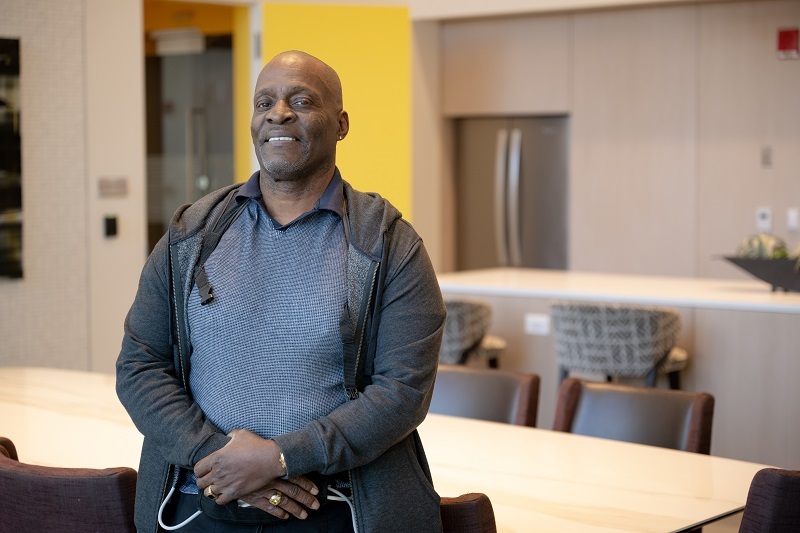Jersey City Man’s Life Saved by Implanted Heart Device

November 01, 2023
Since 2017, Darrin Wilkins of Jersey City, New Jersey, had been experiencing progressively worsening symptoms signaling heart failure, which he wrote off—until one day when he could no longer ignore them.
“I was having shortness of breath and was so light-headed I realized I needed to go to the emergency department,” Darrin recalls. “I told the ambulance to take me to Hackensack University Medical Center because I knew they were a very good hospital.”
Testing at Hackensack showed that Darrin was not getting enough oxygen on the left side of his heart, and he was diagnosed with acute decompensated heart failure. In its early stages, heart failure can be managed with medication and healthy lifestyle changes. But when the disease becomes advanced, treatment gets more complex. Fortunately for Darrin, he was given the option of having an LVAD (left ventricular assist device) implanted to improve his cardiac function.
How LVAD Works
Darrin’s cardiologist, Kanika Mody, M.D., describes the LVAD’s function: “It works by actively sucking out blood from the left ventricle of the heart so that the chamber can rest. It also helps restore circulation to the body without straining the heart.”
Sometimes the device can enable the patient to heal, and the device can be removed later. Other patients will have LVAD support until they are able to receive a heart transplant—as is the case for Darrin.
But before he could qualify to have the LVAD implanted, he needed to undergo weeks of medical treatment so his body could withstand the stress of surgery. He admits he was initially nervous about this surgery, even though he needed it to save his life. “Darrin hesitated and hesitated, but he was dying and he knew it,” Dr. Mody says.
Dr. Mody consulted with cardiothoracic surgeon George Batsides, M.D., chief of Cardiac Surgery and surgical director of Mechanical Circulatory Support at Hackensack, who explained the details of the surgery to Darrin:
- Darrin’s chest would be opened, and he would be connected to a heart-lung machine.
- The tip of LVAD would be inserted into the tip of his left ventricle.
- Once there, it would spin at approximately 5,000 rpm (revolutions per minute), ejecting blood into Darrin’s ascending aorta.
- A cord through his abdomen would connect to the power source and controller.
- Once home from the hospital, Darrin would wear the power source and controller on a belt, which would give him the freedom to go about his daily life and keep his heart functioning.
Immediate Improvement of Cardiac Symptoms
Darrin remembers awakening from surgery and thinking, “I feel pretty good!” Today, after months of cardiac rehabilitation, he is able to take walks—previously, he couldn’t even make it to the elevator in his apartment building. He goes to physical therapy three times a week, including biking and calisthenics.
Most important to Darrin is that he has the health and energy to enjoy time with his wife, Rossana, and their children. At 61 years old, he is working with his medical team toward the goal of receiving a heart transplant. “Dr. Mody saved my life,” Darrin says.
Dr. Mody says Darrin’s prognosis is good thanks to the LVAD. “Most patients who receive it for cardiac support don’t die of heart disease,” she says. Dr. Mody urges patients with the diagnosis to consult with an advanced heart failure specialist as part of their care team. “Heart failure will progress without proper treatment. If you have been diagnosed, don’t simply accept the diagnosis and progressively declining health, but advocate for yourself with your doctors to get the specific treatment your condition requires. The LVAD can really improve the quality of life in heart failure patients.”
Next Steps & Resources:
- Meet our source: Kanika Mody, M.D., and George Batsides, M.D.
- To make an appointment with a cardiologist near you, call 800-822-8905 or visit our website.
- Learn more about cardiac care at Hackensack Meridian Health.
- Schedule a heart screening near you.
The material provided through HealthU is intended to be used as general information only and should not replace the advice of your physician. Always consult your physician for individual care.






